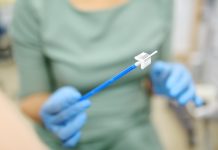Water births have been seen to provide health benefits for both parents and newborns – with lower rates of medical interventions and complications during and after birth
Published in BMJ Open, research highlights how water births have better outcomes than other standard care procedures, with parents experiencing higher levels of satisfaction.
The benefits of water births
A water birth involves using a birthing pool to achieve relaxation and pain relief, either exiting the pool for the birth, so the newborn can emerge into air to breathe, or remaining in the birthing pool for the birth, bringing the newborn to the surface to start breathing.
The team of researchers wanted to compare the extent of healthcare interventions needed during and after labour between the two different types of water birth and to see if outcomes differed between a water birth and standard care (without the use of a birthing pool).
Exploring relevant studies between 2000 and 2021, the team attempt to collect as much data as possible, eventually finding around 36 studies involving 157,546 women that met the eligibility criteria.
The studies included a broad range of interventions and outcomes. These included: induced labour; artificial breaking of waters (amniotomy); stimulation of labour (augmentation); continuous fetal monitoring; opioid use; epidural use (pain relief injected into lower back); pain; C-section; stuck shoulder (dystocia); tearing or cutting (episiotomy) of the vagina or the area between the vagina and the anus (perineum); haemorrhaging after birth; manual placenta removal; infection (mother); mother’s satisfaction; Apgar score (assessment of baby’s wellbeing immediately after birth); newborn resuscitation; rapid shallow breathing of the newborn (tachypnoea); respiratory distress; admission to intensive care; newborn death; infection (newborn); umbilical cord snap (avulsion); breastfeeding.
The collected data provided evidence that a water birth, regardless of whether taken place in or out of the pool, “has clear benefits to women” in obstetric units, where most births take place and where healthcare interventions and complications are more likely than in midwife-led units, noted the researchers.“A waterbirth was as safe as standard care for healthy mums and their newborns.”
“A waterbirth was as safe as standard care for healthy mums and their newborns.”
Does standard care do enough?
Compared with standard care, a water birth significantly reduced the use of epidurals, injected opioids, episiotomy, as well as pain and heavy bleeding after the birth. And it increased mothers’ satisfaction levels and the odds of an intact perineum. And there was no difference in the rate of C-sections.
“Water immersion can significantly increase the likelihood of an intact perineum and reduce episiotomy, an intervention which offers no perineal or foetal benefit, can increase postnatal pain, anxiety, and impact negatively on a woman’s birth experience,” wrote the team.
There were more instances of umbilical cord breakage among water births, but the rate was still low: 4.3/1000 births in water compared with 1.3/1000 births with standard care.
This may be linked to pulling on the umbilical cord when the newborn is brought up out of the water, suggest the researchers.
“Water immersion is an effective method to reduce pain in labour, without increasing risk.”
They acknowledge that information on birth settings, care practices, interventions and outcomes varied considerably among the included studies, and few were carried out in midwife-led units or in the mother’s home, which may have affected the findings of the pooled data analysis.
But they conclude: “Water immersion provides benefits for the mother and newborn when used in the obstetric setting, making water immersion a low-tech intervention for improving quality and satisfaction with care.
“In addition, water immersion during labour and waterbirth alter clinical practice, resulting in less augmentation, episiotomy, and requirements for pharmacological analgesia. Water immersion is an effective method to reduce pain in labour, without increasing risk.”











